Coronaviurs: 84-yr-old Pune man designs low cost ‘Bharucha’ Ventilator

Captain Bharucha
Pune, 9 April 2020- IISER Pune and IUCAA researchers are involved in a multi-institutional effort to produce open-source computer-aided-designs for a mechanical ventilator that is currently in use in hospitals. This work is being carried out in collaboration with Capt. (Retd.) Rustom Bharucha from Bharucha Instrumentation and Control, Pune, India; IUCAA, Pune; IISER Pune, IndoGenius, New Delhi; and King’s College London, United Kingdom. Fretd
Every community impacted by a spike in the number of COVID-19 patients is likely to run short of ventilators. This problem is compounded by supply chain disruption (including export bans) as well as the cost and complexity of most ventilator designs.
The need of the hour is to find a ventilator with a proven design, which has already been used in hospitals and mass produced locally. The plethora of experimental Ambu Bag Compression Devices (ABCDs), originating from the decade old MIT e-Vent design, are a welcome addition at this time of dire need. More sophisticated modern ventilators are too expensive and near impossible to build in resource constrained environments.
In their search, along with others, OpenBreathTech came across the ventilators designed by 84-year old Capt. (Retd.) Rustom K. Bharucha who has been making ventilators for decades. Dr. Naresh Sharma from IISER Pune’s International Relations Office facilitated the contact between researchers at the institute, Dr. Umakant Rapol and Dr. Sunil Nair, with Dr. Prashant Jha, Kings College, London and Nick Booker, Co-Founder of OpenBreath.Tech and IndoGenius. IISER Pune then teamed up with Dr. Suresh Doravari and student volunteers from IUCAA, Pune to create the designs using a model kindly lent by Capt. Bharucha.
Unlike the experimental ventilators, the Bharucha Ventilator has actually been used in hospitals and rural clinics, by over one hundred doctors on thousands of patients, over the last fifteen years. It can also be operated manually in the event of power failure and unlike many designs does not rely on pressurized piped oxygen or air.
What makes the Bharucha Ventilator potentially so useful in the current crisis is the very fact it is robust, relatively easy to make and purely mechanical with no electronics. This is a useful design to build upon to meet the ventilation challenge of the resource constrained Global South – where over half the world’s population live.
The cost per machine when made by an individual buying parts locally should be less than Rs7000 ($95) and when mass produced could come below Rs3500 (~$50). This would make it one of the cheapest ventilators available for the treatment of COVID-19 patients.
Nick Booker, Co-Founder of OpenBreath.Tech and IndoGenius says, “The world needs a “Jaipur Foot for ventilators” – a low cost, open source solution that can be built locally. I was convinced there would be an innovation out there that could at least be the basis of a design which might help save COVID-19 patient lives.”
Dr. Naresh Sharma, Principal Technical Officer – International Relations, IISER Pune says, “The Bharucha Ventilator has a proven track history of being used in hospitals to save lives. We hope that our efforts to make a CAD model and releasing it under open source will help kick-start the innovations defined by the resources available to address the clinical requirements.”
Dr. Sunil Nair, Associate Professor (Physics), IISER Pune says, “The Bharucha ventilator is a beautiful example of frugal innovation, and offers us the possibility of incorporating additional functionalities with relatively minor design modifications. Our agenda as a team is to offer an open source solution of a proven machine that is a purely mechanical in nature – critical in a time where the large scale sourcing of electronic components appears to be a daunting task.”
Dr. Suresh Doravari, Research Faculty IUCAA, Pune says, “We hope that our efforts to make a CAD model of the design and releasing it open source will inspire adaptations and enhancements of the design to local needs.”
Dr. Umakant D. Rapol, Associate Professor (Physics), IISER Pune says, “The mechanics of the design is fairly simple and allows mass-production. It could also be produced in local machine shops with basic metal-working equipment and would accept generous machining tolerances in most parts of the equipment. In addition, by adding a few robust sensors for monitoring flow, pressure and content of gases, the machine can be made fairly versatile.”
Dr. Prashant Jha, Co-Founder of OpenBreath.Tech and Professor of Health Innovations at King’s College London says, “The most beautiful part of this machine is that it is made from parts readily available across the Global South. It uses an AC motor – like a table fan, and that lifts weights enabling the bellows to expand. It is the release of the weight which generates the pressure.
“By changing the weights, you can adjust the pressure. Additional catchments mean the bellows can expand more or less – which gives a manually adjustable volume. These modifications could make the current design more usable. We wanted a purely mechanical design to be available to the world as a Plan B Ventilator – ultimately decisions will be taken by local clinicians as to the manner in which it is used and modified.”
About the OpenBreath.Tech Alliance
OpenBreath.Tech is a rapidly growing network of doctors and engineers across the world working to help keep people breathing. It was founded in response to the COVID-19 crisis. OBT are actively seeking suitable designs to get built and tested in multiple contexts including India, Sub-Saharan Africa and South America. Having reviewed more than 70 projects and prototypes we felt that Captain Bharucha’s ventilator needed to be one of the options available to clinicians and engineers working in resource constrained environments.
Organisations involved:
Bharucha Instrumentation and Control, Pune, India
IISER – The Indian Institute of Science Education and Research, Pune, India
IUCAA – The Inter-University Centre of Astronomy and Astrophysics, Pune, India
IndoGenius – New Delhi, India
KCL – King’s College London, United Kingdom
Institutional leads:
Dr. Naresh Sharma, Principal Technical Officer (International relations), IISER Pune
Dr. Sunil Nair, Associate Professor (Physics), IISER Pune
Dr. Dr. Umakant D. Rapol, Associate Professor (Physics), IISER Pune
Dr. Suresh Doravari, Research Faculty, IUCAA, Pune
Dr. Prashant Jha, King’s College London, Co-Founder OpenBreath.Tech
Nick Booker, Co-Founder, OpenBreath.Tech





